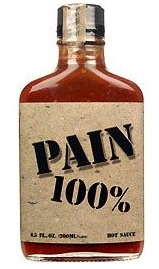Can we make pain our friend?
The so-called King of One-Liners, Henny Youngman, had a famous riff on the medical profession that included my all-time favorite line on pain management:
“I went to the doctor myself and I said, ‘Doc, it hurts when I do that.’” Youngman raised an arm. “The Doc said, ‘Don’t do that.’”
For me, that simple truth lies at the heart of the benefits of running barefoot: throughout millions of years of evolution, the human anatomy has perfected an elegant system of feedback that tells us we are doing something wrong. We know that system quite simply, as pain.
When we eat the wrong foods, we get an upset stomach (TV commercials notwithstanding). When we are running too fast, we get side-stitches in the short term, oxygen debt in the medium term and fatigue in the long term.
And when we runners pronate, supinate, over-stride or heel-strike, we have pain in our feet, legs and skeletal system.
Over the past 30 years, the footwear industry has rushed in with a solution. If you just wear the right shoes, with the right kind and amount of support, or so they would have us believe, the pain will go away.
If that were true, there would be fewer running injuries, fewer knee surgeries, less need for orthotics, and, in general, less pain. That, of course, is not the case.
When we run barefoot or with minimalist footwear, we learn very quickly about over-striding and heel striking. Usually in about the first 20 steps. We automatically adjust and find a rhythm, stride and cadence that works.
I’ll never forget the first time I experienced that particular phenomenon. In February of 2009, I ran my first marathon, even though I had been a runner for about 45 years at that point.
Immediately after that race, which I ran in a pair of Nike Frees, I began to experience tremendous pain in the outside-middle area of my left foot, right in front of the heel bone.
That pain continued for months. Then about May of that year, I happened to pick up Christopher McDougall’s book, Born to Run, and read with great fascination the information he presents about running barefoot.
Figuring I had nothing to lose, I tried it and was amazed at the results. The pain went away almost instantaneously and only returned when I wore shoes. I ordered a pair of Vibram Five Fingers and have been alternating between barefooting and Five-Fingering ever since, with the exception of that first winter, when I chickened out and returned to the shoes.
It has been a transformative experience. And the most compelling benefit, in addition to the sheer pleasure and joy of running, has been the self-correcting aspect of the running experience. I think it may have been ChiRunning founder Danny Dreyer who called it “form school,” or even “reform school.”
I’ve learned, for instance, that I tend to supinate. Not sure why, but I do. So, unlike most other people, I have to adjust my foot placement inward. I make sure I’m not curling my toes under — something I do all too easily — but push off my middle toes on each stride.
I’ve even found that consciously changing my foot placement can alleviate pain not just in my foot, but in my knees or even my quads or hips. And what’s really weird is that I’ve even found that proper foot placement in my right foot alleviates pain in my left hamstring. Go figure.
The point is that the experience has been like going to med school. Or, even more specifically, a med school devoted to me. I still go to the doctor, of course.
But I’ve kinda learned that, while a doctor can often mask or even repair the damage, the person who can best correct the problem and prevent more severe injury is staring me in the face in the mirror every morning. I’ve learned that pain is our friend. And I’ve applied that idea generally, not just about running.
When my body is fighting me about a food, I listen. And when I am feeling tired and dragged out, I look at my schedule. Will it work for everything? Don’t know. But it’s worked a lot for a ton of things, including diet and weight control.
All that from running barefoot, the way nature intended. Physician, heal thyself, indeed.
This essay originally appeared here: http://meditationontherun.blogspot.com


Why does the barefoot and natural running world feel the need to work with the macro-evolution paradigm as if it’s some sort of provable fact? While I appreciate Lieberman’s intelligence to use qualifiers like “probably” and “most likely” when referring to his macro-evolutionary theories, he still puts off the vibe of having certainty to his readers. It’s an unnecessary insertion of certainty in a theory, in my opinion, just leave it out.